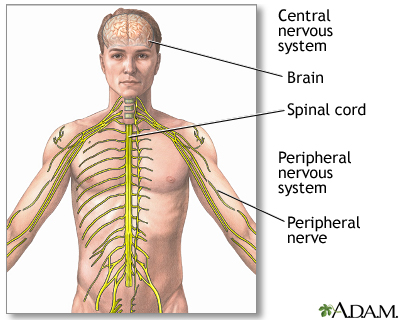
A migraine is a common type of headache that may occur with symptoms such as nausea, vomiting, or sensitivity to light. In many people, a throbbing pain is felt only on one side of the head. Some people who get migraines have warning symptoms, called an aura, before the actual headache begins. An aura is a group of symptoms, usually vision disturbances, that serve as a warning sign that a bad headache is coming. Most people, however, do not have such warning signs. See also:
- Cluster headache
- Mixed tension migraine (features of both a migraine and tension headache)
- Tension headache
CAUSES
A lot of people get migraines -- about 11 out of 100. The headaches tend to first appear between the ages of 10 and 46. Occasionally, migraines may occur later in life in a person with no history of such headaches. Migraines occur more often in women than men, and may run in families. Women may have fewer migraines when they are pregnant. Most women with such headaches have fewer attacks during the last two trimesters of pregnancy. A migraine is caused by abnormal brain activity, which is triggered by stress, certain foods, environmental factors, or something else. However, the exact chain of events remains unclear. Scientists used to believe that migraines were due to changes in blood vessels within the brain. Today, most medical experts believe the attack actually begins in the brain itself, where it involves various nerve pathways and chemicals. The changes affect blood flow in the brain and surrounding tissues.
Migraine attacks may be triggered by:
- Alcohol
- Allergic reactions
- Bright lights
- Certain odors or perfumes
- Changes in hormone levels (which can occur during a woman's menstrual cycle or with the use of birth control pills)
- Changes in sleep patterns
- Exercise
- Loud noises
- Missed meals
- Physical or emotional stress
- Smoking or exposure to smoke
Certain foods and preservatives in foods may trigger migraines in some people. Food-related triggers may include:
- Any processed, fermented, pickled, or marinated foods
- Baked goods
- Chocolate
- Dairy products
- Foods containing monosodium glutamate (MSG)
- Foods containing tyramine, which includes red wine, aged cheese, smoked fish, chicken livers, figs, and certain beans
- Fruits (avocado, banana, citrus fruit)
- Meats containing nitrates (bacon, hot dogs, salami, cured meats)
- Nuts
- Onions
- Peanut butter
This list may not include all triggers. True migraine headaches are not a result of a brain tumor or other serious medical problem. However, only an experienced health care provider can determine whether your symptoms are due to a migraine or another condition.
SYMPTOMS
Vision disturbances, or aura, are considered a "warning sign" that a migraine is coming. The aura occurs in both eyes and may involve any or all of the following:
- A temporary blind spot
- Blurred vision
- Eye pain
- Seeing stars or zigzag lines
- Tunnel vision
Not every person with migraines has an aura. Those who do usually develop one about 10 - 15 minutes before the headache. However, it may occur just a few minutes to 24 hours beforehand. A headache may not always follow an aura. Migraine headaches can be dull or severe. The pain may be felt behind the eye or in the back of the head and neck. For many patients, the headaches start on the same side each time. The headaches usually:
- Feel throbbing, pounding, or pulsating
- Are worse on one side of the head
- Start as a dull ache and get worse within minutes to hours
- Last 6 to 48 hours
Other symptoms that may occur with the headache include:
- Chills
- Increased urination
- Fatigue
- Loss of appetite
- Nausea and vomiting
- Numbness, tingling, or weakness
- Problems concentrating, trouble finding words
- Sensitivity to light or sound
- Sweating
Symptoms may linger even after the migraine has gone away. Patients with migraine sometimes call this a migraine "hangover." Symptoms can include:
- Feeling mentally dull, like your thinking is not clear or sharp
- Increased need for sleep
- Neck pain
EXAMS AND TESTS
Your doctor can diagnose this type of headache by asking questions about your symptoms and family history of migraines. A complete physical exam will be done to determine if your headaches are due to muscle tension, sinus problems, or a serious brain disorder. There is no specific test to prove that your headache is actually a migraine. However, your doctor may order a brain MRI or CT scan if you have never had one before. If you have a migraine with unusual symptoms such as weakness, memory problems, or loss of alertness, an EEG may be needed to rule out seizures. A lumbar puncture (spinal tap) might be done.
TREATMENT
There is no specific cure for migraine headaches. The goal is to prevent symptoms by avoiding or changing your triggers. A good way to identify triggers is to keep a headache diary. Write down:
- When your headaches occur
- How severe they are
- What you've eaten
- How much sleep you had
- Other symptoms
- Other possible factors (women should note where they are in their menstrual cycle)
For example, the diary may reveal that your headaches tend to occur more often on days when you wake up earlier than usual. Changing your sleep schedule may result in fewer migraine attacks. When you do get migraine symptoms, try to treat them right away. The headache may be less severe. When migraine symptoms begin:
- Drink water to avoid dehydration, especially if you have vomited
- Rest in a quiet, darkened room
- Place a cool cloth on your head
Many different medications are available for people with migraines. Medicines are used to:
- Reduce the number of attacks
- Stop the migraine once early symptoms occur
- Treat the pain and other symptoms
REDUCING ATTACKS
If you have frequent migraines, your doctor may prescribe medicine to reduce the number of attacks. Such medicine needs to be taken every day in order to be effective. Such medications may include:
- Antidepressants such as amitriptyline
- Blood pressure medicines such as beta blockers (propanolol) or calcium channel blockers (verapamil)
- Seizure medication such as valproic acid, gabapentin, and topiramate
- Serotonin reuptake inhibitors (SSRIs) such as venlafaxine
- Selective norepinephrine uptake inhibitor (SNRIs) such as duloxetine
STOPPING AN ATTACK
Other medicines are taken at the first sign of a migraine attack. Over-the-counter pain medications such as acetaminophen, ibuprofen, or aspirin are often helpful, especially when your migraine is mild. If these don't help, ask your doctor about prescription medications. (Be aware, however, that overuse or misuse of such pain medications may result in rebound headaches.Chronic rebound headaches typically occur in people who take pain medications more than 3 days a week on an ongoing basis.) Your doctor can select from several different types of medications, including:
- Triptans -- the most frequently prescribed medicines for stopping migraine attacks -- such as almotriptan (Axert), frovatriptan (Frova), rizatriptan (Maxalt), sumatriptan (Imitrex), and zolmitriptan (Zomig)
- Ergots such as dihydroergotamine or ergotamine with caffeine (Cafergot)
- Isometheptene (Midrin)
These medications come in different forms. Patients who have nausea and vomiting with their migraines may be prescribed a nasal spray, suppository, or injection instead of pills. Some migraine medicines narrow your blood vessels and should not be used if you are at risk for heart attacks or have heart disease, unless otherwise instructed by your health care provider. Ergots should not be taken if you are pregnant or planning to become pregnant, because they can cause serious side effects to an unborn baby.
TREATING SYMPTOMS
Other medications are primarily given to treat the symptoms of migraine. Used alone or in combinations, these drugs can reduce your pain, nausea, or emotional distress. Medications in this group include:
- Nausea medicines such as prochlorperazine
- Over-the-counter pain relievers such as acetaminophen (Tylenol)
- Sedatives such as butalbital
- Narcotic pain relievers such as meperidine
- Nonsteroidal anti-inflammatory drugs (NSAIDs) such as ibuprofen
If you wish to consider an alternative, feverfew is a popular herb for migraines. Several studies, but not all, support using feverfew for treating migraines. If you are interested in trying feverfew, make sure your doctor approves. Also, know that herbal remedies sold in drugstores and health food stores are not regulated. Work with a trained herbalist when selecting herbs.
























No comments:
Post a Comment